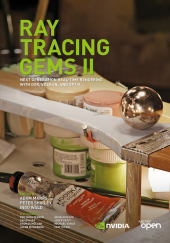 Neuerscheinungen 2019Stand: 2020-02-01 |
Schnellsuche
ISBN/Stichwort/Autor
|
Herderstraße 10
10625 Berlin
Tel.: 030 315 714 16
Fax 030 315 714 14
info@buchspektrum.de |

Tomas Akenine-Moller, Eric Haines
(Beteiligte)
Ray Tracing Gems
High-Quality and Real-Time Rendering with DXR and Other APIs
Herausgegeben von Haines, Eric; Akenine-Moller, Tomas
1st ed. 2019. xliv, 607 S. 40 SW-Abb., 322 Farbabb., 100 Farbtabellen. 254 mm
Verlag/Jahr: SPRINGER, BERLIN; APRESS 2019
ISBN: 1-484-24426-5 (1484244265)
Neue ISBN: 978-1-484-24426-5 (9781484244265)
Preis und Lieferzeit: Bitte klicken
This book is a must-have for anyone serious about rendering in real time. With the announcement of new ray tracing APIs and hardware to support them, developers can easily create real-time applications with ray tracing as a core component. As ray tracing on the GPU becomes faster, it will play a more central role in real-time rendering. Ray Tracing Gems provides key building blocks for developers of games, architectural applications, visualizations, and more. Experts in rendering share their knowledge by explaining everything from nitty-gritty techniques that will improve any ray tracer to mastery of the new capabilities of current and future hardware.
What you´ll learn:
The latest ray tracing techniques for developing real-time applications in multiple domains
Guidance, advice, and best practices for rendering applications with Microsoft DirectX Raytracing (DXR)
How to implement high-performance graphics for interactive visualizations, games, simulations, and more
Who this book is for:
Developers who are looking to leverage the latest APIs and GPU technology for real-time rendering and ray tracing
Students looking to learn about best practices in these areas
Enthusiasts who want to understand and experiment with their new GPUs
Part 1: Ray Tracing Basics
1. Ray Tracing Terminology
2. What is a Ray?
3. Introduction to DirectX Raytracing
4. A Planetarium Dome Master Camera
5. Computing Minima and Maxima of Subarrays
Part 2: Intersections and Efficiency
6. A Fast and Robust Method for Avoiding Self-Intersection
7. Precision Improvements for Ray/Sphere Intersection
8. Cool Patches: A Geometric Approach to Ray/Bilinear Patch Intersections
9. Multi-Hit Ray Tracing in DXR
10. A Simple Load-Balancing Scheme with High Scaling Efficiency
Part 3: Reflections, Refractions, and Shadows
11. Automatic Handling of Materials in Nested Volumes
12. A Microfacet-Based Shadowing Function to Solve the Bump Terminator Problem
13. Ray Traced Shadows: Maintaining Real-Time Frame Rates
14. Ray-Guided Volumetric Water Caustics in Single Scattering Media with DXR
Part 4: Sampling
15. On the Importance of Sampling
16. Sample Transformations Zoo
17. Ignoring the Inconvenient When Tracing Rays
18. Importance Sampling of Many Lights on the GPU
Part 5: Denoising and Filtering
19. Cinematic Rendering in UE4 with Real-Time Ray Tracing and Denoising
20. Texture Level of Detail Strategies for Real-Time Ray Tracing
21. Simple Environment Map Filtering Using Ray Cones and Ray Differentials
22. Improving Temporal Antialiasing with Adaptive Ray Tracing
Part 6: Hybrid Approaches and Systems
23. Interactive Light Map and Irradiance Volume Preview in Frostbite
24. Real-Time Global Illumination with Photon Mapping
25. Hybrid Rendering for Real-Time Ray Tracing
26. Deferred Hybrid Path Tracing
27. Interactive Ray Tracing Techniques for High-Fidelity Scientific Visualization
Part 7: Global Illumination
28. Ray Tracing Inhomogeneous Volumes
29. Efficient Particle Volume Splatting in a Ray Tracer
30. Caustics Using Screen Space Photon Mapping
31. Variance Reduction via Footprint Estimation in the Presence of Path Reuse
32. Accurate Real-Time Specular Reflections with Radiance Caching
Tomas Akenine-M ö ller is a Distinguished Research Scientist at NVIDIA, Sweden, since 2016, and currently on leave from his position as professor in computer graphics at Lund University. Tomas couathored Real-Time Rendering and Immersive Linear Algebra, and has written 100+ research papers. Previously, he worked at Ericsson Research and Intel.
Eric Haines currently works at NVIDIA on interactive ray tracing. He co-authored the books Real-Time Rendering, 4th Edition and An Introduction to Ray Tracing, edited The Ray Tracing News, and cofounded the Journal of Graphics Tools and the Journal of Computer Graphics Techniques. He is also the creator and lecturer for the Udacity MOOC Interactive 3D Graphics.


